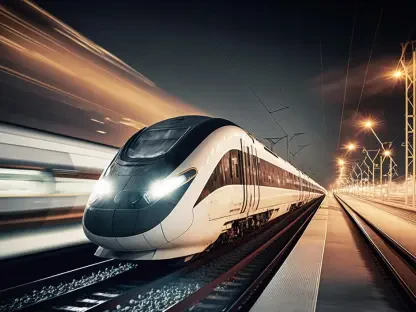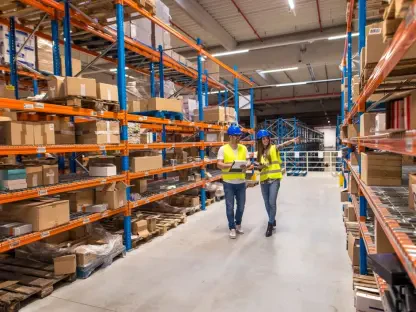As the calendar inches closer to October 1, a proposed 25% tariff on trucks, spearheaded by the Trump administration, looms large over the U.S. industrial landscape, sparking intense debate among manufacturers, truckers, and policymakers. This measure, still awaiting official documentation, aims to shield domestic heavy-truck producers from what has been described as unfair foreign competition. Yet, with nearly 99% of Class 8 trucks and 88% of medium-duty trucks already manufactured within U.S. borders, questions arise about the true necessity and potential consequences of this policy. The tariff’s ripple effects could reshape supply chains, inflate costs, and strain international trade agreements, leaving stakeholders bracing for impact. This complex issue demands a closer look at the motivations behind the policy, its implications for key industry players, and the broader economic ramifications that could unfold in the coming months.
Exploring the Policy’s Foundations
Unpacking the Rationale Behind the Tariff
The driving force behind the proposed 25% tariff on trucks centers on protecting American manufacturers like Peterbilt, Kenworth, Freightliner, and Mack Trucks from external competitive pressures. Proponents argue that this measure safeguards national security and bolsters the financial stability of domestic truckers who form the backbone of the nation’s logistics network. President Trump has framed the tariff as a critical step to ensure that U.S. companies maintain a competitive edge in a global market often skewed by unequal trade practices. However, skepticism persists among industry insiders who point out the already dominant domestic production figures. This raises a fundamental question about whether the tariff addresses a real threat or risks creating unnecessary economic friction. The policy’s intent to fortify American industry is clear, yet its alignment with current market realities remains under scrutiny as the implementation date approaches.
National Security and Economic Motivations
Beyond the protection of manufacturers, the tariff is also positioned as a matter of national security, emphasizing the importance of self-reliance in critical industries like heavy trucking. A robust domestic truck sector is seen as vital to maintaining supply chain integrity during potential global disruptions. Economically, the policy seeks to support truckers facing tight margins by reducing reliance on imported vehicles that might undercut local pricing. Yet, critics argue that the minimal import volume—last year’s figures showed $15.6 billion from Mexico and $4.5 billion from Canada in customs value—may not justify such a sweeping measure. The balance between safeguarding strategic interests and avoiding overreach is delicate, especially when considering that existing tariffs on materials like steel and aluminum already burden manufacturers. This intersection of security and economics paints a nuanced picture of a policy with ambitious goals but uncertain outcomes.
Assessing Industry and Trade Implications
Impact on Manufacturers and Supply Chains
For manufacturers, the proposed tariff introduces a layer of complexity to an already intricate supply chain. Companies like Daimler Truck North America are closely monitoring developments, though they remain cautious in offering detailed predictions. The heavy reliance on foreign-sourced materials such as steel and critical minerals means that additional tariffs could compound existing cost pressures, with firms like Paccar already passing surcharges onto carriers. This cascading effect threatens to raise prices for end users, potentially stifling demand in a competitive market. Moreover, the tariff’s potential to override provisions of the U.S.-Mexico-Canada Agreement (USMCA) could disrupt established trade flows, as noted by experts like Jason Miller from Michigan State University. The risk of tariff stacking—layering new duties atop existing ones—further complicates the landscape, possibly exceeding the policy’s intended protective scope and challenging manufacturers’ operational strategies.
Trade Dynamics and Cost Concerns for Truckers
The interplay between the tariff and international trade agreements adds another dimension of concern for the trucking industry. The possibility of overriding USMCA rules, similar to current tariffs on finished vehicles from Canada and Mexico, could strain relations with key trading partners and disrupt import streams critical to certain market segments. For truckers, who often operate on razor-thin profit margins, the anticipated rise in vehicle costs due to tariff-driven price hikes poses a direct threat to their livelihoods. Industry leaders like Paccar CEO Preston Feight have highlighted competitive imbalances, noting that American-made medium- and heavy-duty trucks face disadvantages compared to those assembled in Mexico under current trade structures. This dynamic suggests that while the tariff aims to protect domestic interests, it may inadvertently burden the very workforce it seeks to support, raising broader questions about the long-term viability of such protectionist measures.
Reflecting on Economic Consequences
Looking back, the discourse surrounding the 25% truck tariff revealed a deep tension between protectionist ambitions and the realities of a globalized economy. The policy, debated intensely as October 1 approached, underscored the challenges of balancing domestic manufacturing support with the risk of escalating costs and trade disruptions. While the intent was to shield American industry and enhance national security, the high level of existing domestic production and pre-existing material tariffs cast doubt on the measure’s necessity. Moving forward, stakeholders must prioritize collaborative dialogue to mitigate potential fallout, exploring alternative strategies like targeted incentives for local production or renegotiated trade terms within frameworks like the USMCA. Addressing supply chain vulnerabilities without imposing undue burdens on truckers and consumers emerged as a critical next step, ensuring that future policies reflect both economic pragmatism and strategic foresight.









